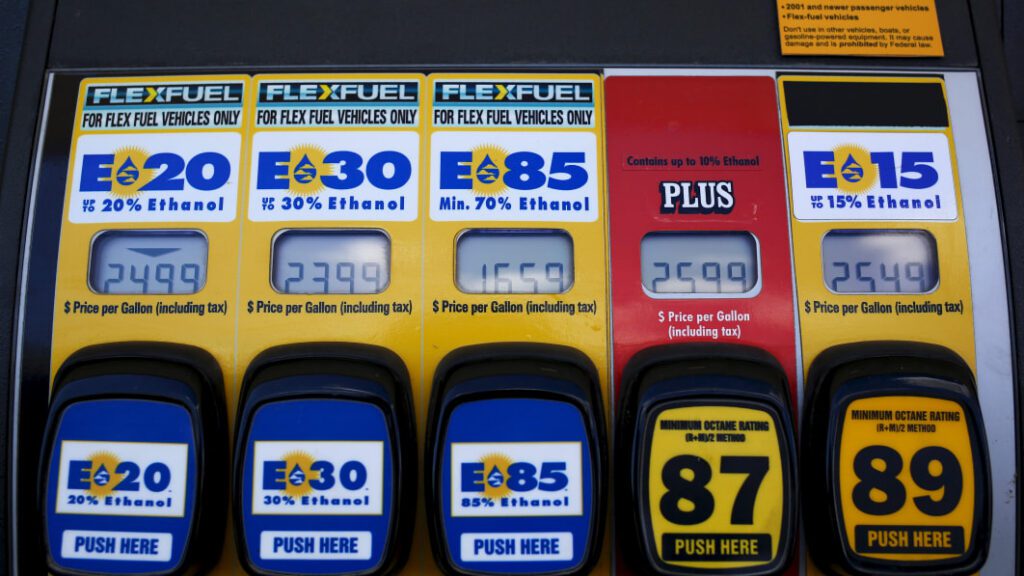Midwest ethanol push could drive up gas prices by 12 cents a gallon

Motorists in the U.S. Midwest could expect to pay more for gasoline under a fuel policy shift demanded by governors in the region, with a new refining industry-commissioned analysis outlining larger-than-expected impacts of the change.
The study, conducted by Baker & O’Brien Inc. for the main U.S. refining trade group, predicts it would cost as much as 12 cents more per gallon to distribute, store and produce a new fuel to adapt with the move, which is part of a bid to encourage filling stations to sell higher ethanol E15 gasoline and offer it year round. That’s in stark contrast to a previous estimate commissioned by advocates of corn-based ethanol that saw only a 2-cents per gallon increase for consumers.
The latest study underscores the high political and economic stakes facing President Joe Biden and the Environmental Protection Agency, which has no latitude under federal law to deny the change — only delay it. Already, formal government action on the issue has been stalled amid opposition from refiners and pipeline operators stoking concerns about the economic consequences amid record-setting inflation.
The White House is reviewing a drafted formal rulemaking notice, setting the stage for the EPA to seek public comment on the plan within weeks — potentially too late to make the change before the summer driving season. The stalemate has drawn the ire of state attorneys general and lawmakers.
At issue is a push by some Midwestern governors to stop giving conventional E10 gasoline a partial waiver from volatility limits meant to curb air pollution. That would put E10 and E15 on the same regulatory footing in their states — and potentially encourage more sales of the higher-ethanol variety. But to meet the EPA requirements, refineries would have to churn out raw, unblended gasoline that is less volatile, essentially creating a boutique fuel for the affected Midwest states. And that, in turn, would prompt a slew of changes across the fuel supply chain, beginning at the refineries forced to forgo using butane and other inexpensive, evaporation-prone gasoline components that make the fuel too volatile.
Refineries typically would need to invest between $50 million and $75 million each to make necessary improvements, such as installing more storage tanks to hold those especially evaporative gasoline ingredients, according to a summary of the analysis that was commissioned by the American Fuel and Petrochemical Manufacturers trade group.
Costs could reach $500 million to $800 million in the first year alone, and potentially be higher if there are disruptions, said Patrick Kelly, senior director of fuels and vehicle policy at the association. “Requiring the manufacture of an entirely new gasoline blend for the Midwest is going to come with a massive price tag,” Kelly said.
The full study, which factored in facility-specific data to create a robust picture of potential impacts, was not made available for review.
It’s not clear that all refineries would make the necessary investments; some could pivot to produce fuel for other states instead. It’s also not certain how many extra expenses would be passed on to consumers. The study found there would be additional near-term costs of 8 cents to 12 cents per gallon to make a new gasoline blend for the region and move it to retail locations, while facilities are still installing new equipment and adapting to the change.
Fuel production in the affected Midwest states would likely fall in the near term, as refineries without enough tanks to store butane and other foregone components curtail the amount of crude they process. Overall, gasoline production from refineries supplying the region would shrink about 125,000 barrels per day, the study found. That amounts to nearly 5% of demand in the region and would be akin to a large refinery going offline during the summer. Diesel production would fall an estimated 33,000 barrels per day.
Biofuel advocates who support the change have stressed that consumers could expect greater access to cheaper E15, potentially more than offsetting extra costs, as more stations opt to offer the blend. When the EPA issued emergency waivers allowing summer sales of E15 in 2022, it cost nearly $1-per-gallon less than E10 in some areas, with a nationwide average discount of 16 cents per gallon, according to a biofuel industry-commissioned analysis.
The administration needs “to act swiftly to protect cleaner, more affordable fuel options at the pump for working families,” Emily Skor, chief executive officer of the ethanol advocacy group Growth Energy, said in an emailed statement. After last summer’s savings, “no one wants to see those options vanish from the marketplace.”



